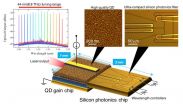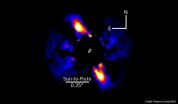QLEDs meet wearable devices
Korean scientists develop ultra-thin deformable QLEDs in the wearable platform
2015-06-02
(Press-News.org) The scientific team, from the Institute for Basic Science (IBS) and Seoul National University, has developed an ultra-thin wearable quantum dot light emitting diodes (QLEDs). The electronic tattoo is based on current quantum dot light emitting diode (QLED) technology. Colloidal quantum dot (QLED's) have attracted great attention as next generation displays. The quantum dots (QDs) have unique properties such as the color tunability, photo/air stability, and are printability on various substrates. The device is paper thin and can be applied to human skin like a sticker.
The team developed the high performance red, green, and blue QLED array, whose resolutions approach 2,500 pixels per inch. This resolution is far superior to other light emitting devices and displays on the market today including ones used in the latest smartphones. The technique is readily scalable over large area. Devices are adaptable to deformed states and thereby built on the unconventional curvilinear substrates including surfaces of various objects. Further mechanical deformations, such as stretching or wrinkling, are also adopted in this technology, which enables QLEDs on the human skin. This breakthrough highlights new possibilities for integrating high-definition full color displays in wearable electronics.
INFORMATION:
The article was published in Nature Communications in May, 2015. The link for the publication is as follows: http://www.nature.com/ncomms/2015/150514/ncomms8149/full/ncomms8149.html.
ELSE PRESS RELEASES FROM THIS DATE:
2015-06-02
To arrange for an interview with a researcher, please contact the Communications staff member identified at the end of each tip. For more information on ORNL and its research and development activities, please refer to one of our media contacts. If you have a general media-related question or comment, you can send it to news@ornl.gov.
SOLAR - Suitability mapping ...
Using remote sensing data, researchers can efficiently determine optimum sites for solar power plants, according to a study led by Olufemi Omitaomu of Oak Ridge National Laboratory. With the target of solar ...
2015-06-02
University of Adelaide researchers have discovered cerebral palsy has an even stronger genetic cause than previously thought, leading them to call for an end to unnecessary caesareans and arbitrary litigation against obstetric staff.
In an authoritative review published in the American Journal of Obstetrics & Gynecology, members of the Australian Cerebral Palsy Research Group, based at the University of Adelaide's Robinson Research Institute, argue that up to 45% of cerebral palsy cases can have genetic causes.
This builds on research published in February this year ...
2015-06-02
A study of marine mammals and other protected species finds that several once endangered species, including the iconic humpback whale, the northern elephant seal and green sea turtles, have recovered and are repopulating their former ranges.
The research, published in the June edition of Trends in Ecology and Evolution, suggests that some species, including humpback whales, have reached population levels that may warrant removal from endangered species lists.
But returning species, which defy global patterns of biodiversity loss, create an urgent new challenge for policymakers ...
2015-06-02
Researchers at Tohoku University and the National Institute of Information and Communications Technology (NICT) in Japan, have developed
a novel ultra-compact heterogeneous wavelength tunable laser diode. The heterogeneous laser diode was realized through a combination
of silicon photonics and quantum-dot (QD) technology, and demonstrates a wide-range tuning-operation.
The researchers presented their work at a Conference on Lasers and Electro-Optics (CLEO) in San Jose, California, on May 13. The related
paper was also be published in Applied Physics Express ...
2015-06-02
A research group at Tohoku University has succeeded in fabricating an atomically thin, high-temperature superconductor film with a superconducting transition temperature (Tc) of up to 60 K (-213°C). The team, led by Prof. Takashi Takahashi (WPI-AIMR) and Asst. Prof. Kosuke Nakayama (Dept. of Physics), also established the method to control/tune the Tc.
This finding not only provides an ideal platform for investigating the mechanism of superconductivity in the two-dimensional system, but also paves the way for the development of next-generation nano-scale superconducting ...
2015-06-02
An international team led by Thayne Currie of the Subaru Telescope and using the Gemini South telescope, has discovered a young planetary system that shares remarkable similarities to our own early solar system. Their images reveal a ring-like disk of debris surrounding a Sun-like star, in a birth environment similar to the Sun's. The disk appears to be sculpted by at least one unseen solar system-like planet, is roughly the same size as our solar system's Edgeworth-Kuiper Belt (commonly called the Kuiper Belt), and may contain dust and icy particles. This work provides ...
2015-06-02
Using a brand new survey method, researchers in Bergen have asked a broad spectrum of people in Norway about their thoughts on climate change. The answers are quite surprising.
Some 2,000 Norwegians have been asked about what they think when they hear or read the words "climate change". There were no pre-set answers or "choose the statement that best describes your view" options. Instead the respondents had to formulate their views on climate change in their own words. The answers have provided striking new insight into what the average person on the street in Norway ...
2015-06-02
Long-term changes in immune function caused by childhood trauma could explain increased vulnerability to a range of health problems in later life, according to new research by the Institute of Psychiatry, Psychology & Neuroscience (IoPPN) at King's College London and the NIHR Maudsley BRC.
The study, published today in Molecular Psychiatry, found heightened inflammation across three blood biomarkers in adults who had been victims of childhood trauma. High levels of inflammation can lead to serious and potentially life-threatening conditions such as type-2 diabetes, cardiovascular ...
2015-06-02
Treatment options for chronic hepatitis C, a serious and life-threatening infection, have improved substantially and several new regimens with shorter durations and improved efficacy and safety profiles are now available.
Groups have raised concerns about the evidence used to support the approval of some newer drugs, however, and the issue has been used to cast doubt on their efficacy and even to question treatment or deny reimbursement.
To address these concerns, the US Food and Drug Administration's Division of Antiviral Products in the Center for Drug Evaluation ...
2015-06-02
This news release is available in French. Montreal, June 2 -- A new study published by the team of Naguib Mechawar, Ph.D., a researcher with the McGill Group for Suicide Studies (MGSS) of the Douglas Institute (CIUSSS de l'Ouest-de-l'Ile de Montreal) and associate professor in the Department of Psychiatry at McGill University, sheds new light on the disruption of astrocytes in depression. Astrocytes, a class of non-neuronal cells, have previously been implicated in depression and suicide.
However, it was not known whether these cells were affected throughout the brain ...
LAST 30 PRESS RELEASES:
[Press-News.org] QLEDs meet wearable devices
Korean scientists develop ultra-thin deformable QLEDs in the wearable platform




